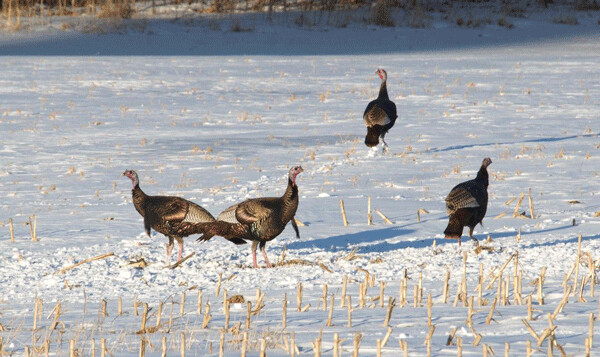News & Articles
Browse all content by date.

Snow crunched under my boots the other morning as I crossed the driveway to my car. A few dusky lavender clouds were just sailing away in the quiet dawn. Quiet only until a flock of wild turkeys exploded out of the nearby hemlock grove. Their big wings flapped and crashed through the branches as they spooked from the safety of their nocturnal roost. Three? Five? Six? of their big bodies zoomed over my head and vanished. Just a few minutes later, I chased a couple of these modern dinosaurs down the road in my car as they ran, searching wildly for the best route over the snowbanks. So I spent that morning researching turkeys.
First, their explosive flight is remarkable. It’s easy to forget that these big, awkward birds can fly at all—until they suddenly flush up from the road or out of the trees. As you might remember from Thanksgiving dinner, turkeys have both white meat and dark meat. Those two types of muscles power different activities. Dark meat is well-oxygenated and therefore functions best during aerobic activities involving endurance—like walking, running, and scratching in the leaves for food. It’s no coincidence that if you like dark meat then you choose a turkey leg or thigh.
The white meat is made of fast-twitch fibers that excel at rapid, short-term activities, like bursting into flight and startling unsuspecting people or escaping a hungry bobcat. After all of that commotion, wild turkeys rarely fly more than about 100 yards. It makes sense, then, that white meat is on their breasts and wings. Birds who migrate long distances—like ducks and geese—have breast and wing muscles that are dark for endurance.
Turkeys have excellent eyesight and great hearing, too, which is why it can be difficult to sneak up on them. Hunters still manage to find a way, though, and back in 1881, wild turkeys vanished from Wisconsin. It wasn’t just unregulated hunting that drove their decline. At that point, turkeys were only native to far southwest Wisconsin. Settlers quickly cut the oaks, which served both as nighttime roosts and food sources for the turkeys. Domestic poultry brought disease, too, which didn’t help.
A series of comically unsuccessful reintroduction efforts began as soon as 1887. Thousands of pen-raised birds and wild/domestic turkey hybrids were released by the state of Wisconsin between 1929 and the 1960s. These birds didn’t have the right instincts to survive predators and harsh winters. But it was difficult to catch the purely wild birds, so what do you do?

Turns out, you invent the technique of rocket netting. Have you heard of rocket netting? I hadn’t. But I mentioned it around the kitchen table that night with my new roommates. Ally and Laura are currently trapping small mammals in the Chequamegon-Nicolet National Forest, and staying at the Museum’s staff house for a few weeks, but these two wildlife researchers have worked on a wide variety of projects around the country. “Oh yeah,” said Laura, “I’ve used rocket nets to catch turkeys in Delaware.”
Laura described the process of loading explosive charges into metal tubes and then attaching them to a big net. The rockets are mounted on posts. After that, you wire the system up to an electrical firing line, retreat to the blind, and wait until the turkeys come to a pile of bait. With luck, when you fire the rockets, they’ll carry the net over the birds and trap them. The technique was invented in the 1950s and quickly proved its usefulness.
We found some videos of the rocket netting process on YouTube, and it looks like a booby trap from an Indiana Jones movie, with a thick net launching onto the flock, followed by much squawking and flapping. “They’re really pretty docile,” Laura continued. “They didn’t really peck or bite, but you did have to watch out for their spurs.” She pointed to a tiny scar still visible in the palm of her hand. Tom turkeys have a sharp claw, or spur, on the back of their ankles that’s useful for self-defense. With the use of rocket netting, wild turkeys from Missouri were caught and released in southwest Wisconsin in 1976. In return, Wisconsin gave Missouri three ruffed grouse per turkey. The 300-plus turkeys soon multiplied, and Wisconsin began an in-state trap and transfer program. Wild turkeys now occupy all 72 counties in Wisconsin—even up north where biologists originally thought that winters would be too harsh.
Turkeys are a wildlife conservation success story. Sometimes too successful, like when turkeys move into residential areas and become pests. It helps that they eat just about anything related to seeds or insects. Sightings seem high this year, with plenty of acorns for them to forage on. They’ve also been spotted eating frozen crabapples while awkwardly perched in tiny trees. And even when deep, fluffy snow causes some turkeys to starve to death, their numbers can bounce back in a single breeding season. With explosive flight, explosive nets, and explosive populations, these common birds are pretty entertaining to have bursting out of my hemlock grove..
Emily’s second book, Natural Connections: Dreaming of an Elfin Skimmer, is now available to purchase at www.cablemuseum.org/books and at your local independent bookstore, too.
For more than 50 years, the Cable Natural History Museum has served to connect you to the Northwoods. Come visit us in Cable, WI! Our new Curiosity Center kids’ exhibit and Pollinator Power annual exhibit are now open! Call us at 715-798-3890 or email emily@cablemuseum.org
| Tweet |


